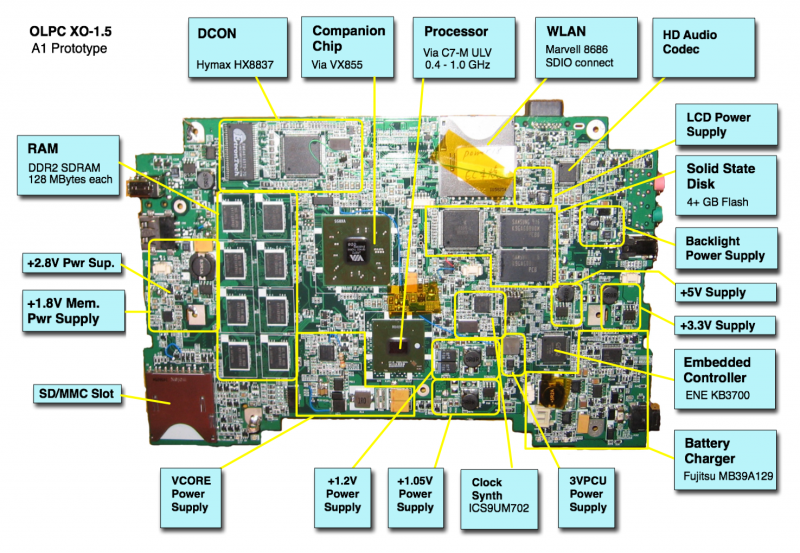XO 1.5 A2
XO-1.5 Laptop Alpha test model second A-Test, also known as A2.
Contents
Description
The A2 prototype motherboard is a revised version of the A1 motherboard, fixing many of the small problems encountered with the layout. OLPC should receive thirty of these around the second week of July, 2009. All are dedicated to development and testing, with about half going to hardware/firmware and half to Linux.
Supporting documentation for these boards are (in PDF):
These are the same as for A1 boards.
Please note that production boards will likely have different pin mappings and connector locations.
Identification
- Bare circuit board, no case or display
Photographs:
Software Support
XO-1.5 use Q3axx firmware releases.
Restrictions
Heat
We seem to be OK in this department. Most (all ?) A2 motherboards in laptops with a back present have heat spreaders. Closed up laptops without a heat spreader should not damage themselves (if they do, please file a Trac bug).
WLAN
A Marvell 8686 SDIO module is populated on the motherboard. Unfortunately, there is a pin (Card Detect) on the VX855 that has to be tickled for the SDIO interface to work, and wad forgot to hook it up. There is no software work-around, and while it is possible to reach that ball, it is a very difficult and risky (ruining the motherboard is the most likely outcome) procedure. Thanks to Gary Chiang, an outstanding engineer at Quanta, we have five laptops with functioning WLAN interfaces.
For others, we recommend a USB/Cat5 dongle.
NAND Flash
All boards are populated with a Phison PS3006 NAND Flash controller and two NAND Flash chips for testing, providing 4 GBytes. There is also an IDE connector populated on the "top" of the board (side with LCD connectors). The inclusion of this chip does not imply it will be present in the final XO-1.5
Power-On Issues
A few A2 boards don't power-on reliably. On some boards, and more frequently after the chipset has warmed up, the short flash of red on the battery light indicates that the chipset never issued a PCIRESET when powered on. A solution is fixing the +1.2V power sequencing. The +1.2VSUS supply also needs sequencing for reliable power-on.
